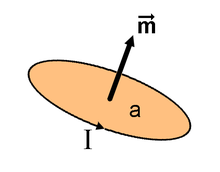| Articles about |
| Electromagnetism |
|---|
 |
 Magnetic moment m of a current I, enclosing an area a. | |
Common symbols | m |
|---|---|
| SI unit | Ampere-meter2 |
| In SI base units | m2⋅A |
| Dimension | L2I |
In electromagnetism, the magnetic moment or magnetic dipole moment is the combination of strength and orientation of a magnet or other object or system that exerts a magnetic field. The magnetic dipole moment of an object determines the magnitude of torque the object experiences in a given magnetic field. When the same magnetic field is applied, objects with larger magnetic moments experience larger torques. The strength (and direction) of this torque depends not only on the magnitude of the magnetic moment but also on its orientation relative to the direction of the magnetic field. Its direction points from the south pole to north pole of the magnet (i.e., inside the magnet).
The magnetic moment also expresses the magnetic force effect of a magnet. The magnetic field of a magnetic dipole is proportional to its magnetic dipole moment. The dipole component of an object's magnetic field is symmetric about the direction of its magnetic dipole moment, and decreases as the inverse cube of the distance from the object.
Examples of objects or systems that produce magnetic moments include: permanent magnets; astronomical objects such as many planets, including the Earth, and some moons, stars, etc.; various molecules; elementary particles (e.g. electrons); composites of elementary particles (protons and neutrons—as of the nucleus of an atom); and loops of electric current such as exerted by electromagnets.